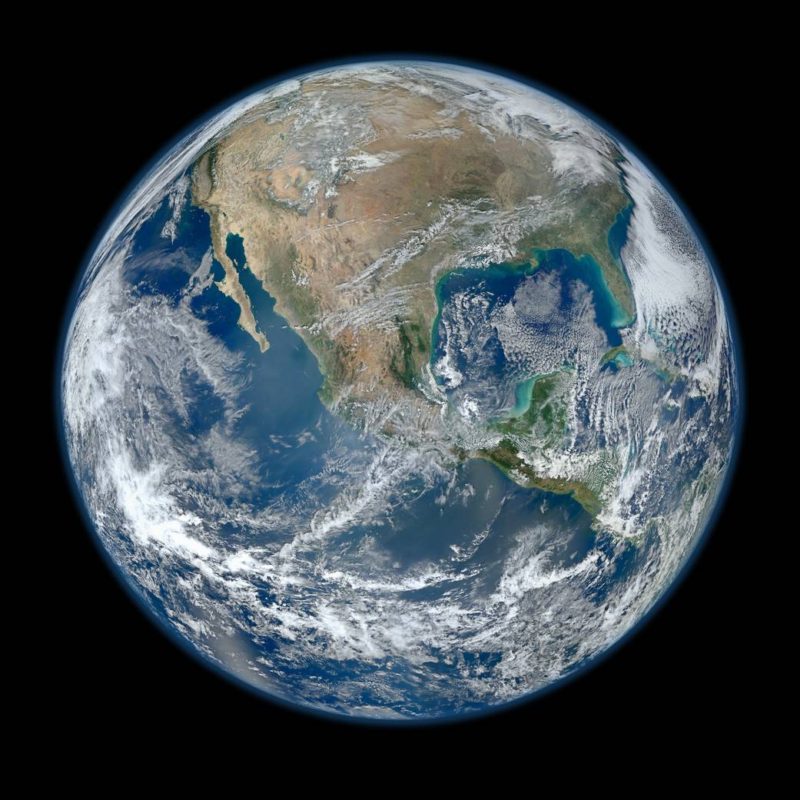April 1, 2017 2:09 pm
Happy April Fool’s Day: Debunking 8 Relatively Common Scientific Misconceptions
Today’s guest blog post is by StarTalk intern Kirk Long. Kirk is majoring in physics while minoring in mathematics and piano at Idaho State University.
For April Fool’s Day I thought it might be fun to take a look at some common scientific misconceptions that are still held by a variety of people. Read below to debunk them with me, and share this with your crazy uncle (especially if your uncle is BoB) who still thinks the Earth is flat. And just to be perfectly clear, everything in this post (except for the myths) is true.

Our “Blue Marble” 2012. Image Credit: NASA/NOAA/GSFC/Suomi NPP/VIIRS/Norman Kuring.
1: CERN could create a black hole that will swallow the Earth
This theory was popularized semi-recently by the book (and movie) Angels and Demons. While CERN is certainly an incredibly cool place, where physicists are recreating violent particle collisions and trying to replicate the conditions present at the beginning of the universe, we aren’t in any practical danger from it. CERN is testing these things on a very small scale, and even if CERN could create a black hole (which has never been observed) it wouldn’t be the type of scary black hole you’re probably visualizing right now. Theoretically, CERN experiments might produce something called a quantum black hole, but these are also theoretically popping in and out of existence all over the universe at any given time. They are so small that they almost immediately evaporate (Yes, black holes can evaporate — read here for an explanation of the process of evaporation, which is caused by Hawking Radiation) and thus pose no real danger to life here on Earth. If we could figure out how to experimentally manufacture them, however, they would be extremely useful to physicists seeking to unlock the secrets of gravity — so really we should hope CERN accidentally creates and observes miniature black holes.
2: The seasons are caused by our distance from the Sun
If you’ve got any relatives or friends on the other side of the equator, this one can be debunked as fast as you can make a phone call. It is true that the Earth’s orbit is not perfectly circular, and thus there are times when we are slightly closer or farther away from the Sun. This does play some role in temperature variations, but it’s a small effect when compared with the effect of Earth’s axial tilt. The Earth is angled 23.5, and this tilt means that during some times of the year the Northern hemisphere receives more daylight and in other times the Southern hemisphere receives more. More radiation equals more heat, and thus we end up with the seasons. This is why things stay relatively temperate all year long at the equator, and why near the poles during some parts of the year it is almost constantly light or dark.
3: Theories are just hunches
This is often used by people trying to defend their position on climate change, evolution, or the big bang. As Neil once said, “the good thing about science is that it’s true whether or not you believe in it” and unfortunately, you can’t just pick which theories you want to “believe” in. It is unfortunate that colloquially the word theory doesn’t have much significance, but in the scientific world a theory must be incredibly well-tested and explained before being accepted. Gravity is “just” a theory, but whether you believe in it or not Newton’s universal law of gravitation will shape the rest of your life on this Earth — just in the same way as the inevitability of climate change will.
4: There’s a dark side of the moon
Technically I guess there is a “dark” side of the moon twice a month — once during the full moon and once during the new moon — but there is certainly no perpetual dark side. We only see one side of the moon because it’s tidally locked with the Earth — that is it rotates exactly once each time it orbits us — but the opposing side goes through phases just like the side we see does. During our new moon the opposite side of the moon is full, and during our full moon it is completely dark.
5: You’d explode without a space suit in the vacuum of space
If you’re going to try to go on a spacewalk in your birthday suit you won’t get off that easy — dying exposed in the vacuum of space would still take long enough for it to probably be incredibly painful and all-around unpleasant. Realistically, you could probably actually survive for somewhere around 30 seconds to a minute (although I don’t think you would want to test this). If you’re a nerd like me you might remember in Battlestar Galactica (season 3 episode 15) Chief Tyrol and his wife Cally get trapped in a leaky airlock, and they eventually survive by being vented into space for a few seconds to be quickly picked up by a Raptor. There’s a similar scene in 2001: A Space Odyssey, and both are actually relatively realistic. The vacuum of space would cause you to go unconscious within about 15 seconds (because there’s no oxygen) and the lack of pressure would cause your blood to boil (for the same reason that you can boil water at a lower temperature on top of a mountain). You might end up hypothermic if you went for a spacewalk in the shade, or burned if you went walking in the sun, but you probably could survive for a few seconds. If no one managed to rescue you before you died, your tissues would continue to swell (as the fluids in them boiled) and your lungs might burst, but you wouldn’t explode. You’d probably end up looking like a bloated idiot doomed to be preserved that way until gravity decided to bring you back down to Earth (or wherever you made the dumb decision to go into space without a suit).
6: We only use 10% of our brains
Contrary to what many movies would have you believe (including most recently the film Lucy). This is just flat-out wrong. You use almost all of your brain all of the time. It is true that certain parts of your brain are more active when you’re doing certain tasks (i.e. if you’re eyes are closed you’re probably using your visual cortex less), and unfortunately there’s no secret part of it waiting to be activated to turn you into a superhuman genius. Check out our Cosmic Queries: Super Powers episode to hear Neil explain how the original quote this myth comes from — “The brain is so complex we only know what 10% of it is used for” — was misconstrued and further elaborate on why we are already using our brain’s full potential.
7: If you drop a penny from high enough you’ll kill someone
If you were to drop a penny from a tall building like the Empire State Building in New York and somehow had the superhuman accuracy to hit your arch nemesis unsuspectedly walking below, you’d probably just make them mad at the worst. A penny’s terminal velocity is somewhere between 30 and 50 miles per hour (depending on conditions) and although that sounds pretty fast because a penny has so little mass that doesn’t equate to much force. Even without air resistance, if you dropped it from the top of the Empire State Building it would only get up to about 200 miles an hour, which is still not fast enough to even break someone’s skin let alone kill them. They tested this on Mythbusters, and in their experiment they shot a penny at about 700 miles an hour at a gel skull. Despite the speed at which the penny hit the skull, because of its large surface area it bounced right off. You’d have better luck if the penny hit edge on, but it’s unlikely the penny would hit edge on in a natural environment and even then it would have to be going much faster than it physically can to do any real damage.
8: The Earth is flat
This is sadly more common than one would think, and it has been making a bit of a resurgence lately as several high profile celebrities have come out as flat-earthers, including rapper BoB and NBA star Kyrie Irving. While everyone who’s passed the second grade knows this notion is audaciously ridiculous, there are actually several easy ways you can test this yourself. There’s a great article from PopSci here but I’ll summarize my favorite ways. Most obviously, if you’ve ever seen a picture from space you know that we call our home the Blue Marble for a reason. Second most obviously, if you’ve ever looked at the moon, the Sun, or any of the planets through a telescope, you might have noticed they were all round, and assuming you’re not an extreme narcissist who thinks the Earth is extra special, you might make the inference that the Earth is also round. If you’ve ever been to the ocean, watch for ships near the horizon. They will appear to sink beneath the water or rise up out of the horizon, easy evidence for the curvature of the Earth. Likewise, if you’ve ever travelled and noticed that the stars and constellations are different depending on where you are, you have just indirectly proved the Earth is round. If the Earth were flat we’d only ever be able to see the “top” of the sky, and that would be rather boring. If you’ve ever travelled on an airplane, especially a flight that crosses an ocean (because oceans are flat and it’s easier to notice the curvature) if you pay close attention to the horizon you can normally make out the curvature of the Earth. If you’re into rap battles, you can read this article from NPR about the time Neil and his nephew Stephen Tyson got into a rap battle with BoB over this flat Earth nonsense.
Did we miss your favorite science hoax or conspiracy? Sound off in the comments and let us know, and have a wonderful April Fool’s Day.
Get the most out of StarTalk!
Ad-Free Audio Downloads
Priority Cosmic Queries
Patreon Exclusive AMAs
Signed Books from Neil
Live Streams with Neil
Learn the Meaning of Life
...and much more

 Become a Patron
Become a Patron

